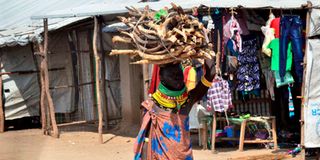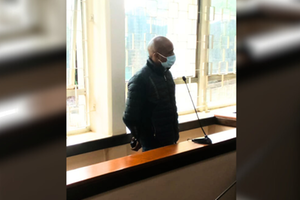Healthcare remains a big challenge for refugees and host communities

A woman carrying firewood at Kakuma Refugee Camp. Like everyone else, the refugee deserves decent standards of living.
Today, June 20 is World Refugee Day.
It is 70 years since the United Nations promulgated the Convention Relating to the Status of Refugees in 1951 as an international treaty on caring for persons who are out of their countries of nationality owing to a well-founded fear of being persecuted for reasons of race, religion, nationality, membership of a particular social group or political opinion.
This day was first designated in 2001 when the UN celebrated 50 years of the refugee convention.
Significantly, the day reminds us that humankind is far from ending the problems that underlie and drive violent conflict within nations. Such problems lead to forced migration of people across national border and lead to what is today a protracted global refugee challenge. According to official United Nations High Commissioner for Refugee (UNHCR) sources, there were 82.4 million forcibly displaced persons by the end of 2020.
It is the great irony of history that when the UNHCR was created in 1950 in the wake of the humanitarian crises that World War II occasioned, it was believed that refugee problems would be over within three years. It was also expected that UNHCR would disband at the end of that period.
Situation compounded
Tragically, the situation has steadily become compounded. Refugee camps that were initially set up as temporary structures to provide urgent and essential humanitarian support to people fleeing their homes have become permanent fixtures. At 30 years today, Daadab and Kakuma Refugee camps are the oldest in Africa, with a combined population of over 500,000 refugees. Forced migrants are living out their full lives in these places, while all the time nursing the hope that they will someday leave, to enjoy bright futures in places they could call home.
Kakuma Refugee Camp came into existence in 1991, with the arrival of young people who were given the generic name of the Lost Boys of Southern Sudan. These youth were aged anywhere from early teen years to early adulthood. From an initial figure of just about 8,000, the numbers in this camp today rank to just slightly below 200,000. From the original Southern Sudanese youth, the camp is populated by migrants from as many as 22 countries, from the Eastern and Central African region and beyond. It continues to experience population explosion, both from fresh migrations and from in-camp births.
Population pressure
While some of the original refugees, as well as later migrants, have re-migrated and resettled in other countries, population pressure looks set to go on, without any clear signs on when this camped life could possibly end. Between April and December 2019, for example, the population grew from 188,135 to 191,500, largely as a factor of new births within the camp. As in all other environments, population growth exerts corresponding pressure on social amenities. The situation is especially complicated in refugee contexts. Kakuma is no exception, thirty years after the first refugees arrived.
Like everyone else, the refugee deserves decent standards of living. Children are an especially vulnerable demographic in refugee camps, everywhere in the world. They require not just good educational support to secure their future, but also good healthcare right from prenatal attention to delivery and aftercare. It is an established fact that health facilities in forced migrations are often rudimentary and inadequate. Surgical facilities, for example, can be a big challenge in camps that are mostly located far from metropolitan centres, where comparatively better health facilities are found.
Data by health charity Kids Operating Room (KidsOR) show that as many as 1.7 billion children globally are unable to access surgery for conditions that basic surgical intervention could treat. These are more children than, say, those who die from HIV, malaria and TB, combined. As people are now living out full-length lives in refugee camps and refugee settlements, long-term healthcare must be both anticipated and provided. Needless to say, essential human wants are not put on hold the moment someone becomes a refugee. We remain human regardless of where we may be and, accordingly, require dignified and satisfactory facilities and care even in refugee situations.
This month, KidsOR in working with UNHCR, the International Rescue Committee and the Biltema Foundation, installed a paediatric theatre at Kakuma Refugee Camp. The intervention is significant not just because it is the first time it is happening, but because it will serve both refugees and host communities in Turkana County. To paraphrase Nicola Wood, the philanthropist co-founder of KidsOR, the operating room will provide essential care to tens of thousands of children in the camp and beyond, giving them a chance for a better future.
Long migration narrative
Contemporary migration scholars have reminded us that the human story through the pages of history is one long narrative of migration. People are unceasingly seeking better lives away from the places they have memorialised as home. As long as these homes don’t work out well for them, they will keep moving. And they will still need access to basic amenities, including healthcare.
Yet we must also go beyond these interventions, to deal with underlying triggers and drivers of refugeehood, as well as the factors that lead to protraction of refugee camps.
Rosemary Mugwe is Africa Director, KidsOR. [email protected]




